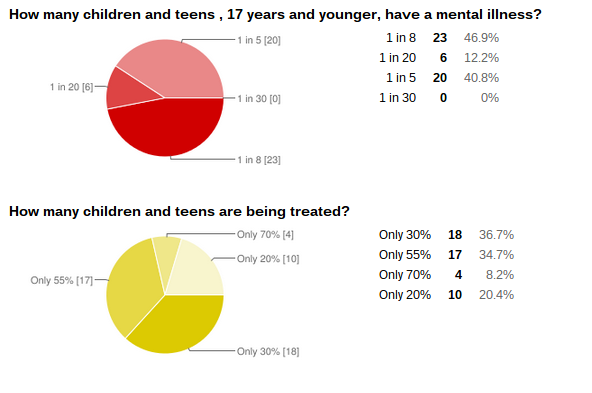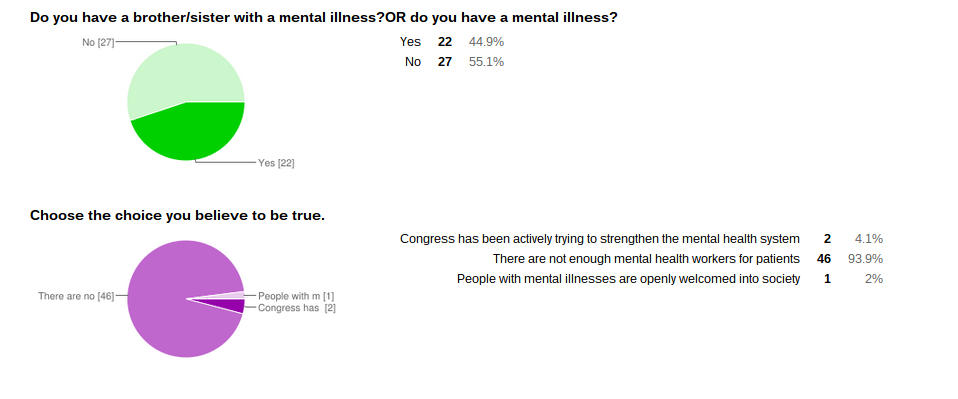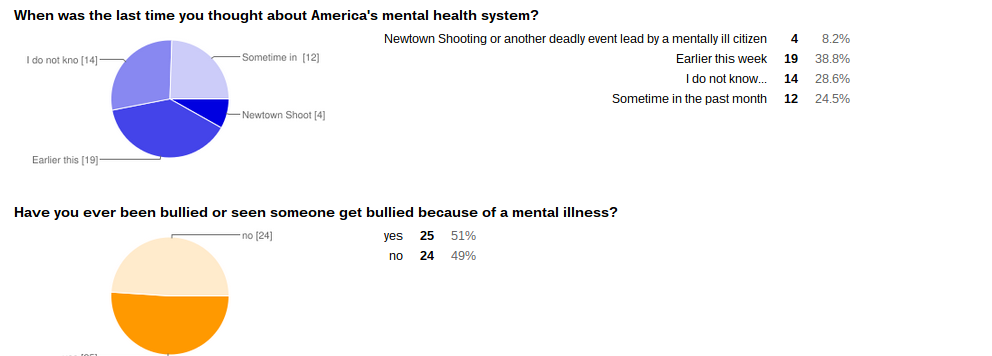Factors I feel are contributing to the broken mental health care system, as discussed in my blogpost 1.
Public Ignorance of prevalence, local and global impact
"Mental-shaming", average citizens being unsympathetic to those who are mentally challenged, making it difficult for them to feel comfortable in society
In my last blogpost, I introduced my You and the World project, where I described my methods in trying to bring awareness to America's broken mental health care system, and provided factual information to corroborate my claims. I stated that my inspiration stemmed from my younger brother, who is autistic. Moreover, I expressed that the broken system is a result of public ignorance of mental health illnesses, the impact they have on citizens, and the impact they have on the world. Because of this, I explained how I plan to bring awareness to this issue by finding a unique way to educate the public about mental illnesses and the treatment patients receive. In this blog post, I will be elaborating on the original research, data and perspectives that I have collected through a survey and interviews, portion of my You and the World project. In addition to my original research, I will include new, credible information concerning the structure of America's mental health care system.
Since my last blog post, I have collected an agglomeration of insightful facts and statistics covering the perspectives of those who work in the mental health field, the prevalence of mental illnesses, and the public's ignorance/indifference about this very important topic. For starters, while doing more research, I came upon a very interesting article on Michigan's Local News website. The article includes quotes from Paul Ippel, executive director of Network 180, Kent County’s public mental health and substance abuse resource agency. "When a person is admitted to the hospital[for physical reasons], we send flowers and cards...There was a time people wouldn't say the word cancer and now we talk (openly) about going for cancer treatment, but we’re reluctant to say we've been admitted to a psychiatric hospital," he states. His words specifically resonated with me because it gave me a unique perspective other than my own. As you can recall from my previous blog post, I mentioned that it was important for citizens who were not personally affected by mental illness to not ostracize those who were different. I made a point that people who were deliberately ignorant, as well as those who were subconsciously passive, made integration into society especially difficult for those dealing with anxiety, autism, ADHD, anorexia, bipolar disorder, schizophrenia, etc. However, when I read Ippel's response, my train of thought expanded, and I began to wonder if reluctance to be open about one's own mental health challenges and needs was also a factor of why the system has remained tarnished. He references cancer, which was once a sensitive topic, which people opted to take a circuitous route in discussing. Now cancer is widely spoken about and research, innovations, and new breakthrough therapies are coming at the result of the salient discussion. His point correlates to one of the factors I previously discussed: Mental shaming.

Excerpt where I spoke about mental shaming in my previous blog post.
I am still passionately driven by the belief that American citizens are not building a comfortable environment for those who are mentally-ill to express themselves. Even at an early age, kids are bullied and isolated for holding differences. For example, 2.7 million children are being bullied every year,and over 100,000 of them missed school due to a bullying incident in 2010. It is even worse for children who who are mentally challenged. Approximately half of adolescents with autism, intellectual disability, speech impairments and learning disabilities are bullied at school, new research suggests.That’s much higher than the rate of bullying faced by typically developing students, (about 1 in 10 are victimized by their peers).
Visuals created by me to portray the juxtaposition:


When I interviewed my fellow classmate, Jevon Price, to receive a youth perspective. I received some interesting responses.
1) Do you believe that the national discussion of our mental system was resuscitated by the Sandy Hook Elementary School shooting that occurred in 2012?
Yes. I feel like people do not discuss mental health because they want to live in blissful ignorance.
--> Do you think the discussion made any type of impact? Whatever impact it made was certainly very short lived. People are not even talking about it anymore and when it was a huge topic, the discussion got diverted to gun control and whatnot.
2) According to a Time Magazine article, there are only 7,500 psychiatrists, while 20,000 are needed. What do you believe engenders such a significant shortage? What implications do you think the shortage causes?
People do not care if they are not personally confronted with mental illness. These shortages cause more accidents like Sandy Hook if people are not being treated
3) How knowledgeable do you believe teenagers are about mental illnesses and how patients receive treatment?
They are only knowledgeable when dramatic things occur.
4) Do you feel as if the general public is concerned with making mentally-ill patients feel accepted and welcomed in society?
No. I feel like people are so into themselves that they do not really care and take into consideration of people who are different
5) In what ways do you think the services that the current mental health care system provides can be enhanced to be more coordinated and organized?
You need more psychiatrists and to bring public awareness because if people don't know how much of an impact mental illnesses have in our lives, as a country, they are honestly not going to care.
6) Can you name some positive facets of the current system?
To be completely honest...no, mainly because I do not know a lot about the current system.
7) Can you name some negative facets of the current system?
Well I know that it must not be at its best due to the school shooting and I know that it is somewhat uncoordinated. Also, the current system is not taking advantage of technology and media. We have computers, cellphones, TVs! You need to make your case heard through these devices. It s the only way people will hear you.
8) In your opinion, does the good outweigh the bad, or vise versa?
I don't really know much about the good, so I will have to say that the bad outweighs the good.
I was inspired to interview a young voice because I believe that as youth, we hold a lot of great ideas and can make an impact on the world, hence the You and the World project (haha!), I believed that an interview would be a unique way to gather original research.
Highlights from interview:
"...people do not discuss mental health because they want to live in blissful ignorance"- I think this quote relates back to when I discussed people not making the effort to learn more about mental illness. Perhaps they feel uncomfortable discussing it, afraid they will offend someone, or simply do not care.
"...We have computers, phones, TVs! You need to make your case heard through these devices. It's the only way people will hear you."- I found this response especially significant because lately I have been discussing how I want to bring awareness to this issue, however I have not specified how exactly I want to do so. Hmmmm…
In addition to a student interview, I conducted a survey.


Correct Answers
1 in 4
Only 40%

1 in 5
Only 20%

Survey Conclusion:
I decided to do this survey because I not only wanted to test how much my friends, and adults I know, knew about mental illnesses and the system,but I also wanted them to share stories of times they had experienced someone being bullied due to having a mental illness or a time when they were bullied.
Anonymous Stories I received:
I've seen it happen where someone can't speak correctly because of their illness and others make fun of it.
When I was in high school, I noticed someone being bullied. I didn't do anything about it. It still haunts me.
Someone I know has autism and he was made fun of for not being able to keep up in the classroom. Long story short I almost beat up people…
I would rather not, it's traumatizing. It really is a horrifying experience and truly humiliating.
When I was in second grade, one of my best friends had autism and kids would always make fun of him and hit and tease him because of his disabilities.
9 more stories
Although these stories were short and simple,they have left a lasting impact on me. I am sure that if more people were willing to share stories like this then the world will truly know how important it is to care about the mental health care system and treat everyone kindly, despite their uncontrollable differences.
At last, through my student interview and my interview where almost 49 students,friends, and adults,responded, I learned many things. For starters, I did not expect the respondents to perform so well on the surveys. Maybe the youth is as ignorant as I predicted? This brings the question: Why aren't there more kids sharing their stories, making people care, devoting their time to sparking a discussion about the mental health care system? My answer is that kids feel powerless sometimes. In my Agent of Change plan, I want to empower kids. I want to create a virtual environment, where they can feel safe about sharing their stories, anonymously. I want adults to see how many stories there are. I want to bring awareness.
Specifically, in my Agent of Change, I will create a website, a safe blog, where everyone can vent and share their stories, without worrying that they will be reprimanded or teased. I understand that sometimes the society we live in does not support the mentally-ill, but I also believe that they will see the importance of the issue once they see how many kids are struggling with the bullying this engenders. Not only will I create a website, but I also plan an event at The Franklin Institute to bring awareness to the issue. 
